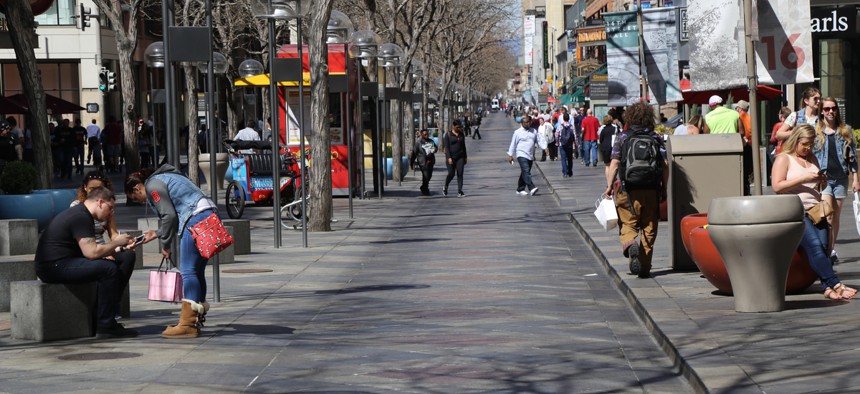Reducing Barriers to Shelter and Services in Denver

Denver's 16th Street Mall. Shutterstock
A cross-sector team sees a new way forward after being told by homeless that the current model was “fundamentally broken.”
Editor’s Note: This is the third in a series of four contributed articles on the Government Entrepreneurial Leadership Accelerator program in Colorado, highlighting four teams’ efforts to find new approaches to vexing public policy issues. You can learn more about the program from Route Fifty’s original article on the topic, “In Government, ‘Failure Is Just an Opportunity to Learn.’”
DENVER — You see homelessness every day on your way to work. You think your local government can improve the way this vulnerable population is served—but that’s someone else’s problem. Then, without warning, it becomes yours.
The question that was assigned to our Government Entrepreneurial Leadership Accelerator team was, in essence, “How might the City and County of Denver do a better job of providing temporary housing and shelter options prior to housing access, while at the same time improving access to housing?” From the end of boot camp until pitch night we had only six weeks to find an answer.
Our initial step into fieldwork was touring any day or overnight shelter that was willing to have us: Denver Rescue Mission, Samaritan House, St. Francis, Urban Peak, Volunteers of America Family Motel. At each location we met with staff members and asked candid questions to get a comprehensive picture of the opportunities available to clients and what a client might experience.
After visiting with service providers, our team thought there might be room to improve the outreach process so unsheltered Denverites could better connect with existing services, but first we needed to hear from our target clients. To find people from the homeless community who actively choose to go unsheltered, we attended meetings of a grassroots, homelessness advocacy group as well as conducted empathy interviews with people in Civic Center Park.
What we heard from these groups is that, barring extreme temperatures, they simply would not go to a shelter. It seemed no amount of outreach would convince these people to access a shelter. In their eyes, it was a model that was fundamentally broken. It was time for us to pivot.
After our round of interviews with these individuals, our executive sponsors at GELA pointed us in the direction of a low-barrier model from New York and encouraged us to think about how Denver might draw from that type of program. Within a day we had discovered a similar model from the west coast called the Navigation Center that would eventually form the substance of our proposal.
Navigation Centers are different because they all but eliminate three common barriers that chronically homeless people face when accessing shelter: partners, pets, and possessions. Navigation Centers allow couples of any gender to sleep in the same room, kennel animals on site, and provide clients with enough storage space to accommodate up to a shipping container’s worth of stuff.
Nowhere in Denver were these barriers being addressed, so we saw in the Navigation Center model an opportunity to get more people on a stable path into housing. From this point forward our focus shifted from improving outreach to bringing a Navigation Center to the Mile High City.
As convinced as we were that we had found the answer to our problem statement, other stakeholders were not enthusiastic initially. We had three weeks until pitch night to change their minds.
It’s tough to say how exactly we were able to get the green light to drive our ideas forward, but we suspect it was a combination of repetition and necessity. Every time we brought up the Navigation Center it was better received than the last. Every time we reminded stakeholders of our project deadline, resistance dissipated. Clock ticking, we turned our attention to pitch night and worked intensely to craft the right language.
Like many public policy issues, homelessness is difficult to talk about, and pushing for innovation in the space is even trickier. If you believe some part of the system is failing, inefficient, or broken, it can be difficult to communicate without alienating someone trying to make a difference.
As the members of our team return to our jobs and schoolwork, we can’t say for certain what will happen to our efforts this summer. There’s a long way to go before any part of our proposal will become a reality, but the wheels are in motion and we’re excited for the future.
PREVIOUSLY on Route Fifty:
James Bradbury is a student at University of Colorado Law School.
NEXT STORY: The Future of American Jobs Is Taking Care of the Elderly





